What makes Zamak ideal for high-efficiency die casting?
Understanding the Fundamentals of Zamak Die Casting
Zamak alloys, primarily composed of zinc, aluminum, magnesium, and copper, are widely recognized for their exceptional performance in high-efficiency die-casting operations. Compared with other materials used in aluminum die casting or magnesium alloy casting, Zamak’s lower melting point significantly reduces cycle times and tooling wear. The zinc die casting process allows rapid filling of molds with excellent dimensional accuracy, making it ideal for applications that demand tight tolerances, such as locking systems and consumer electronics.
Zamak’s high fluidity enables the production of intricate geometries that would otherwise require secondary machining. Combined with CNC machining prototyping, engineers can validate complex mold designs before full-scale production, optimizing both performance and manufacturability.
Manufacturing Efficiency and Process Integration
In die casting manufacturing, productivity is highly dependent on thermal stability, mold life, and cycle consistency. Zamak alloys—such as Zamak 3 and Zamak 5—exhibit superior castability and low shrinkage, minimizing post-processing requirements. Integration with rapid molding prototyping and sheet metal stamping further enhances throughput, particularly in high-volume industries such as automotive manufacturing and power tool production.
Engineers often utilize gravity casting for pre-series runs, refining gating design and thermal control before transitioning to high-pressure Zamak die-casting lines. This multi-process approach ensures that part consistency and tooling reliability are maintained throughout the entire lifecycle.
Material Properties That Drive Performance
From a material science perspective, Zamak’s uniform grain structure and inherent corrosion resistance make it ideal for precision casting applications. The alloy’s mechanical strength surpasses that of most unalloyed zincs, while its superior impact resistance outperforms traditional aluminum alloys under dynamic load.
Variants like Zamak 2 and Zamak 7 offer improved ductility, providing enhanced fatigue performance for components subjected to repetitive motion—common in e-mobility assemblies and electrical housings.
Enhancing Durability Through Surface Treatment
For long-term protection and aesthetics, Zamak parts benefit from advanced post-treatments. Chrome plating enhances wear resistance and provides a reflective finish suitable for visible consumer parts, while powder coating delivers corrosion protection for industrial applications. These coatings, combined with proper thermal management, extend service life even in humid or abrasive environments.
Conclusion
Zamak’s combination of fluidity, strength, and low-temperature castability makes it the alloy of choice for high-efficiency die-casting production. Its synergy with diverse processes—ranging from injection molding to 3D printing prototyping—and compatibility with multiple finishing techniques ensure excellent scalability and product reliability across industries.



